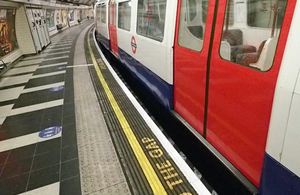Report 05/2021: Fatal accident at Waterloo Underground station
RAIB has today released its report into a fatal accident at Waterloo Underground station, London, 26 May 2020.

A train (not involved in the accident) in the northbound Bakerloo Line platform at Waterloo
Summary
At about 10:10 hrs on 26 May 2020, at Waterloo Underground station in London, a passenger fell into the gap between the northbound Bakerloo line platform and the train from which he had just alighted. A large gap existed between the train and the platform because of the track curvature at the location of the passenger’s fall. The passenger was unable to free himself and the train departed with the passenger still in the gap, crushing him as it moved off. He remained motionless on the track and was subsequently hit by a second train that entered the station.
The accident occurred when there were no staff or other members of public nearby to assist the fallen passenger. Train despatch on the Bakerloo line platforms at Waterloo was undertaken by the train operator (driver) using a closed-circuit television system to view the side of the train alongside the platform. With only his head and arm above platform level, the passenger was difficult to detect on the despatch monitors, and was not seen by the train operator. The operator of the following train was unaware of the passenger because their attention was focused on the platform and the train’s stopping point, until after the train had struck the passenger.
The investigation found that London Underground’s risk assessment processes did not enable the identification and detailed assessment of all factors that contributed to higher platform-train interface (PTI) risk at certain platforms. Consequently, although London Underground had implemented some location-specific mitigation measures at the PTI, it had not fully quantified the contribution of curved platforms to the overall PTI risk, and so was unable to fully assess the potential benefits of additional mitigation at these locations.
The investigation also found that the model used by London Underground to quantify system risk makes no allowance for non-fatal injuries, and so understates the risk of harm to passengers at the PTI and presents an incomplete picture of system risk, with the potential to affect London Underground’s safety decision making.
Recommendations
RAIB has made three recommendations to London Underground. The first relates to the need to recognise and assess location-specific risks so they can be properly managed. The second deals with the need to ensure that safety management processes include the ongoing evaluation of existing safety measures at stations, and provide periodic risk assessment for individual locations at intervals which reflect the level of risk present. The third recommendation relates to the need for effective delivery of actions proposed by internal investigation recommendations.
Notes to editors
- The sole purpose of RAIB investigations is to prevent future accidents and incidents and improve railway safety. RAIB does not establish blame, liability or carry out prosecutions.
- RAIB operates, as far as possible, in an open and transparent manner. While our investigations are completely independent of the railway industry, we do maintain close liaison with railway companies and if we discover matters that may affect the safety of the railway, we make sure that information about them is circulated to the right people as soon as possible, and certainly long before publication of our final report.
- For media enquiries, please call 01932 440015.